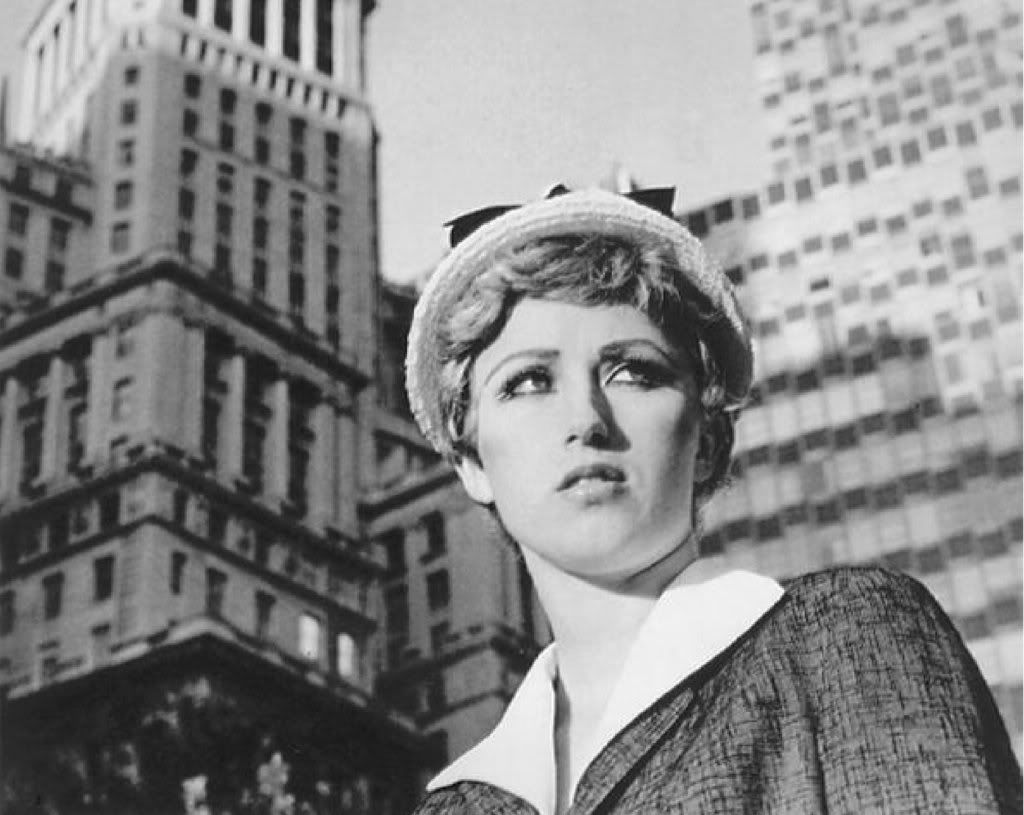People who buy art purely as an investment are amongst the lowest scum of the art world. But in my view, not only are they soulless amoral parasites, but they're dopes as well. They are always doing things like buying Warhols and Koons and Hirsts, which are already overpriced. Seriously, they go against the basic investment advice of "buy low, sell high."

Cindy Sherman, Untitled Film Still, 1978
I recently read an article about Cindy Sherman in ArtKabinett. Now Sherman is in the news a lot because of her big retrospective at MoMA. ArtKabinett's article, "Cindy Sherman Photos Fetch Millions," discussed how her prices have changed over the years.
Along with the hitchhiker and the librarian, the city girl is among the most popular photos from the series, said Janelle Reiring, a partner at Metro Pictures gallery, which has represented Sherman since 1980. “I believe they were priced at $200 each” when the gallery started working with Sherman, Reiring said. “Cindy has sold them previously out of her studio for $50 each.”In short, her photos were priced like the art of many young emerging artists at their first gallery shows. ($200 in 1980 translates to approximately $550 in 2012 dollars.) Obviously, those photos are worth a lot more now.
Shortly after a major Cindy Sherman retrospective opens at New York’s Museum of Modern Art on Feb. 26, one of her most famous images will be sold at Sotheby’s.So $200 in 1980 turns into $150,000 in 2012. The return on that investment is substantially more than the S&P 500, gold, or just about anything else you can think of. So this fact alone suggests that in some cases, buying the work of emerging artists is a good investment strategy. But, of course,this depends on your ability to pick winners, and in any investment field, picking winners--stocks, commodities, real estate, etc.--that outperform the market is really hard. That's why people invest in index funds that track broad indices like the S&P 500. That gives investors the ability to hedge because they know that, on average, they can't pick winners.
[...]
The 8-by-10-inch black-and-white photograph depicts a young working woman, wearing a crisp suit and an anxious expression, standing amid big city buildings. It’s part of Sotheby’s contemporary-art sale on March 9 in New York and has a pre sale estimate of $150,000 to $200,000.
So an art investor who decided in 1980 to take the dangerous path of investing in emerging artists could hedge her investment by buying a lot of emerging artists' work. So instead of buying one $200 piece by Cindy Sherman, this investor would have bought, say, 100 $200 pieces, one of which was by Cindy Sherman. Let's say that the other 99 pieces declined in value and by 2012 they were worth nothing. Well, the return is still decent, but now it's not quite as good as the S&P. So if your ability to pick winners among emerging artists has a 1% success rate, this is not a good investment. But if you can pick 2 winners out of 100 emerging artists, it's well worth doing--you're beating the S&P 500. (This only works if you take a buy and hold strategy.)
Here's a chart that shows this succinctly:

Various investment scenarios involving emerging artists
Obviously the third strategy, picking 2 winners out of 100 artworks purchased, is the champ. (The top strategy being entirely unrealistic.) So all you art investors out there, stop buying that blue chip art. Go to the scrappy galleries that show young artists, to the alternative art spaces, to the artist-run spaces, and buy a lot of art by emerging artists. Hold on to it for 20 or 30 years, and while most of it will be worth less, if you have managed a 2% rate of picking future art stars, you will have come out way ahead!
Now if you actually like the work, all the better. But this strategy is designed for the art investor who has no interest whatsoever in aesthetics, beauty, truth and all that art stuff--he is only interested in ROI. This is a high ROI strategy. (And if your interest in art is zilch, for a standard "2 and 20" fee, I will act as your art adviser and buy all this stuff for you. All you need is a belief that I can pick 2 winners out of 100 artists. Call me, bubbeleh!)




No comments:
Post a Comment